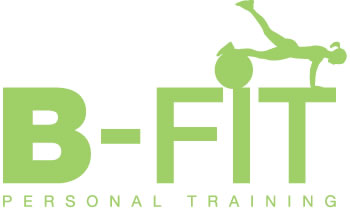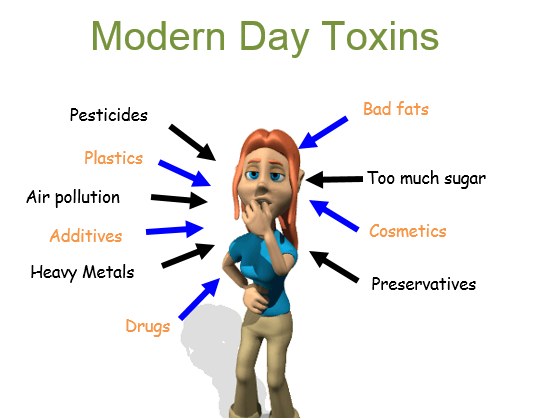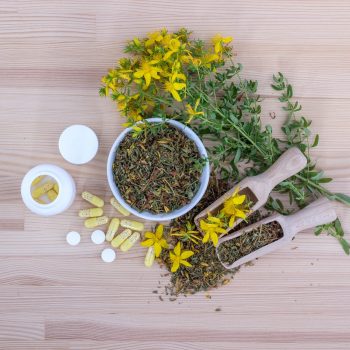Although you may think that you’re completely healthy, in this first instalment of Don’t Diet… DETOX!!!, I’m going to share with you all the ways we are being bombarded with toxic chemicals on a daily basis. So, if you’re carrying any extra weight around your middle, have cellulite on your tummy and legs, or are suffering with skin issues, insomnia or brain fog (or even a combination of all the above), then it’s fair to say that you also have toxin overload. And if that’s the case, it also means that no diet will work for you to lose weight permanently — EVER!
So, what is toxin overload? Well, it’s a physical state that occurs in your body when its detoxification pathways become overburdened by the presence of an excessive amount of toxins, which eventually leads to a slowdown in the elimination of these harmful chemical substances. Toxic overload can become exacerbated by a number of factors, such as having chronic constipation, not getting enough nutrients, overexposure to environmental pollutants, and consuming pharmaceuticals, recreational drugs, alcohol and tobacco. There’s also toxins in most processed foods, which have ingredients that were grown using pesticides and herbicides. And unfortunately, the same pesticides and herbicides are also used to grow conventional fruits and vegetables (which is why I always emphasise that my clients eat as much organic food as possible!).
The signs your body will show when you have an overload to toxins built up can manifest in various ways, including difficulty in concentrating, irrational mood swings, lack of energy, general fatigue — and unexplained weight gain. This is because your body stores excess toxins in your fat cells, especially around your tummy. And the more toxins you have in your body that aren’t eliminated through sweat, urine and faeces, the more fat cells will accumulate and grow to hold onto them — it’s your body’s way of protecting you against excess toxins). That’s why the end result of being overloaded with toxins will have a detrimental impact on your overall health and wellbeing. So, if you want to have a flatter tummy, and be slim and trim for summer, then it’s important to be mindful of these signs and seek out appropriate support from someone like myself, who has helped many lovely ladies like yourself overcome this issue — the sooner you do so, the less painful it will be! What this all means is that ‘detox’ isn’t just a trendy buzzword made up by millennials. Unfortunately these days, we all need to be detoxing as part of a regular maintenance routine to stay on top of our health.
How Many Toxins Are We Exposed To Daily?
Chemicals have pervaded our daily lives for decades, infiltrating our food, water, air, clothing, home and the plastics that surround us everywhere, causing detrimental impacts on not only the environment, but on our bodies themselves. The US and China, in particular, stand out as potentially the most toxic environments on the planet, but we’re not that far behind. And these toxins infiltrate our bodies, organs, bloodstreams and cells, not only through eating them, but also through breathing and skin contact.
Sources like industrial processes, consumer goods and environmental contamination contribute to much of the exposure, while government agencies and environmental organisations often conduct research to assess the prevalence of the toxic chemicals in our environment and their potential impact on human health. However, scientists are awakening to the realisation that the chemicals present all around us are more toxic than previously believed. Therefore, when we recognise that our health and wellbeing extends beyond what we eat and exercise, it’s crucial to be mindful of these harmful substances and take proactive measures to eliminate them from our lives whenever possible.
Some of the chemicals with the highest health concerns include*:
Bisphenols (BPA, BPF, BPS), which are used to make plastics, including water bottles and takeaway food containers. These chemicals are known hormone disruptors and have been shown to increase the risk of certain cancers. They’re found in tinned food linings, electronic toys and the paper receipts given to you after every retail transaction. Tip: always tell the cashier you don’t want a receipt!
Parabens, the most common preservative, have been widely reported to disrupt hormones by causing havoc to oestrogen levels. Unfortunately, they are found in the vast majority of personal care products, including shampoos, body creams and lotions, bath and shower gels, baby wipes, toothpastes and sunscreens.
Pesticides are consumed by everyone everyday, unless you’re eating 100% organic and even then, there’s the chance that these chemicals can travel to a certified organic farm if the crop on the farm next door is constantly being sprayed. Pesticides are used to kill weeds and insects or weeds, but are detrimental to our health, especially glyphosate, which is even sprayed to ‘harvest’ organic wheat and grain in the United States.
Flame retardants, some of which have been classified as carcinogenic (meaning accumulation of these chemicals in your body causes cancer). They’re used on all your furniture, including your mattresses, electronics and building materials.
Formaldehydes, which bind colour pigments to cloth and act as fire retardants (as well as preserve dead bodies). Are known to irritate the skin and mucous membranes, cause hypersensitivity and are carcinogenic to the nasal pathway. They are found in furniture, toys, cleaning products and the chemical air fresheners sold at the supermarket.
PFAs and PFOs, otherwise known as per-fluorinated chemicals, or ‘forever chemicals’, repel water and grease, but they also cause fertility issues and are classed as carcinogenic. They’re found in waterproof clothing, toys and make up the non-stick surface of the pots, pans, air fryers in your kitchen. Using pure stainless steel or cast iron cookware is the only way to avoid cooking your food in these toxic products.
Phthalates are plasticisers that are found in the soft plastic of stuffing for cuddly toys, food packaging and synthetic fragrances. Known as DEHP, DBP and BBP, they’re hormone disrupters and cause issues with fertility.
Persistent organic pollutants like PCBs, dioxins and DDT are used as surfactants and flame retardants. However, they are also known to raise your risk of cancer, cause endocrine and reproductive disruption, increase the risk of birth defects in pregnant women and even bring on euro-behavioural impairment. They were banned under the Stockholm Convention, but still remain in the environment, including in some recycled plastics.
Triclosan, one of the main products in all the toxic hand sanitisers many now carry in their handbags. This pesticide is also found in products like toothpaste, cutting boards, yoga mats and even some cosmetics. Unfortunately, though, it is a well-known a hormone disruptor, can cause severe skin irritation and actually promotes the proliferation of bacteria that are resistant to drugs.
*Source: House of Commons Environmental Audit Committee report, Toxic Chemicals in Everyday Life, July 2019
And that’s not even mentioning one of the biggest toxins around — EMFs or electromagnetic frequencies, which are constantly being emitted from mobile phone towers and masts to all of your wireless devices, even though you can’t see them. In fact, over the past decade, there has been a huge rise in this type of toxic exposure, which has resulted in a significant increase in reported cases of nervous system hypersensitivity and illnesses including immune system dysfunction, reproductive disorders and even some cancers in people who live close to mobile phone masts.
So, as you can already gather, the toxic soup that we live in doesn’t help us at all when it comes to weight loss. And that’s why in Part 2 of my Don’t Diet… DETOX!!! blog, I’m going to share the Top 10 Signs of Toxic Overload, as well as the empowering steps that you can take to help your body detox in a natural and healthy way that will help you shed the excess flab off your tummy, arms, bottom and legs — for good! So, be sure to keep an eye out for the next instalment…
Love, Gaynor x





